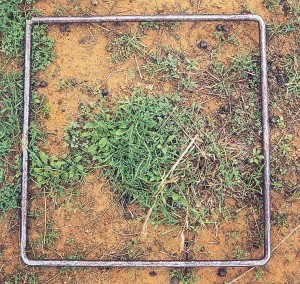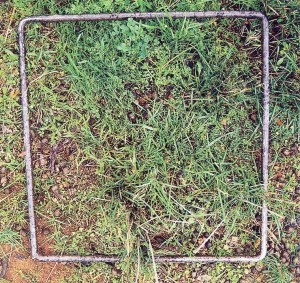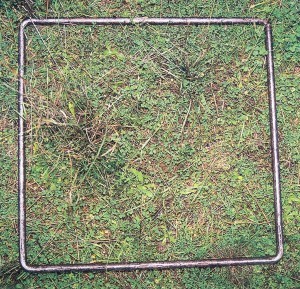Maintaining groundcover for water infiltration
By Regional Agricultural Landcare Facilitator, Rohan Leach
March 2020
With the recent rain, producers across the Central West will be noticing that paddocks with good groundcover have responded with increased pasture growth compared to those paddocks with less groundcover.
In areas that have low groundcover, rainfall will not be used as efficiently due to increased runoff and the possible loss of topsoil. In the short term in is vital that we allow groundcover levels to rebuild over the next few months in order to minimise the negative impacts of low groundcover. At the same time, looking to the next drought, it is important we learn these hard lessons in order to allow farm businesses to seize the opportunities that rainfall events like this provide.
Impact of raindrops on soil
Soil is vulnerable to the impact of raindrops which, when striking bare soil, breakdown soil structure. These soil particles detach and often form a seal or crust on the soil surface, preventing water infiltration. Vegetation, along with other groundcover, slows the velocity of rain droplets intercepting the destructive force of the droplet. Ground cover also slows the passage of run-off water to give it more time to infiltrate soil.
Minimise runoff and erosion and improve pasture quality
Managing adequate levels of groundcover is the most effective way to minimise run-off and erosion. Research has shown that at least 70% groundcover is required to prevent soils being affected by erosion. This percentage is higher again in sloping country.
In addition to managing erosion, the feed quality of a pasture will be of a higher standard in paddocks with adequate ground cover. Annual weeds like cathead (Tribulus terrestris), marshmallow (Malva parviflora) and common pigweed (Portulaca oleracea) are colonisers of bare earth and renowned for their poor grazing qualities. Animal health issues associated with these species include nitrate poisoning, photosensitisation and staggers.
Pastures respond faster when not overgrazed
Pastures that have not been overgrazed are also quicker to respond and reach ideal herbage masses sooner. Plants grazed below 5cm in height will need to draw on root reserves to drive regrowth of leaves. This process requires a relatively longer time period for leaves to regrow compared to leaving plants with sufficient leaf to complete normal photosynthesis levels.
Reduced evaporation from more groundcover
Adequate levels of groundcover can also reduce evaporation. For example, research undertaken in the NSW Northwest Slopes showed that almost 75% of annual rainfall can be lost as evaporation from the ground surface. This evaporation can be halved if ground cover, including plant litter, is increased from 40% to 70%. Also, by increasing ground cover, runoff is reduced, and by using deep rooted perennials further losses through deep drainage are minimised. By combining all of these factors, producers can utilise much more of their annual rainfall, resulting in increased profits from improved pasture or crop production. This increases the time that soil moisture is available to plants and the period that plants are actively growing.
Figure 1: Examples of groundcover percentages

40% groundcover

70% groundcover

90% groundcover
How to assess groundcover
Assessing groundcover is therefore an essential practice that producers or their advisors should be undertaking. A basic tool that anyone can carry out is estimating the percentage groundcover of a paddock using a 50cm x 50cm quadrat or square (pictured in Figure 1).
It helps provide producers with management decisions around pasture and gives an idea of the risk of erosion of that paddock. By being able to assess groundcover, landholders are able to assess their risk of erosion and implement management decisions to rectify potential issues.
Quadrat measurement
The steps to undertake quadrat measurement are as follows:
- Select areas to monitor:
- Make sure the areas being assessed is representative of the entire area.
- Mark the areas on a map so that you can revisit the site in future years. This will give you a good indication of change over time.
- Decide on time of year to monitor:
- Groundcover is often at its lowest level prior to the autumn break, so this is the best time to assess the risk of soil loss through erosion.
- Estimate groundcover
- Using your 50cm x 50cm quadrat, walk along the transect you selected in Step 1. Throw the quadrat at random along the transect and visually assess the groundcover in the quadrat. Use Figure 1 as a guide.
- Photographic records can be used as a reminder of what pasture cover was like.
In situations where groundcover is insufficient, there are a number of options open for producers to reduce risk of erosion. By growing perennial grasses and plant trees and shrubs in areas of high erosion risk, farmers are able to suit enterprise to soil type thus reducing incidences of erosion. In gullies and other high risk or rehabilitation areas, using organic mulches (woodchips, straw or compost) is another option however it can be expensive and so should be limited to these areas.
Groundcover is crucial to farm businesses, both grazing and cropping enterprises. It enables us to store more soil moisture and utilise it for longer providing more flexibility to the farm system. If you would like to know further information about groundcover, assessing ground cover and soil erosion management contact your local LLS Ag services officers or LLS website for further resources.
References
L. Kahn & J. Earl (2009), ‘Grazing Management Fact Sheet 2, Managing plants to increase pasture growth rate’, Agricultural Information and Monitoring Services
D. Lang & W. McDonald (2005), ‘Agfacts, Maintaining groundcover to reduce erosion and sustain production’, NSW Department of Primary Industries
M. Naughton & C. Bourke (2009), ‘Primefact 723, Tribulus: Caltrop and yellow vine’, NSW Department of Industry and Investment
B. McGufficke & J. Lowien (2007), ‘Groundcover lifts water infiltration’, NSW Department of Primary Industries
Images: F. Baker, G. Turner & M. Mitchell (2014), ‘Manage ground cover’, EverGraze, Future Farm Industries CRC